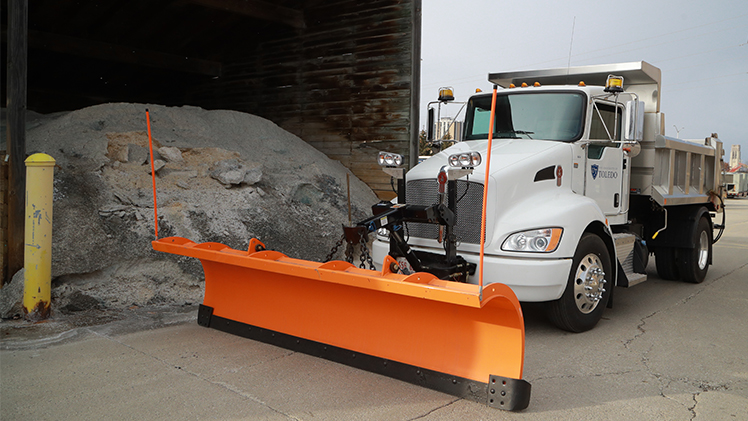Salt keeps roads safe during winter, but using more than needed is dangerous for freshwater ecosystems like the Great Lakes, which are the source for public drinking water and the home of fish and other aquatic life.
Scientists at The University of Toledo studying salt pollution are collaborating with the Ohio Environmental Protection Agency, Partners for Clean Streams and the Toledo Metropolitan Area Council of Governments (TMACOG) to investigate the extent of the issue locally and help communities adjust road salt methods to reduce its harmful impacts.

Using more salt than needed to de-ice winter roads is dangerous for freshwater ecosystems. UToledo scientists are collaborating with state and local partners to reduce salt pollution.
Funded by the Great Lakes Restoration Initiative, the project is located within what the EPA calls the “Maumee Area of Concern,” making it a priority for aquatic habitat restoration.
“Not much salt is needed to have the desired de-icing effect,” said Dr. Bill Hintz, assistant professor of ecology based at the UToledo Lake Erie Center. “We apply way too much salt to our parking lots, driveways and sidewalks than is needed. Smarter use of salt will really help reduce pollution of our fresh waters and our drinking water supplies.”
The regional smart salting partnership, which started in January 2022, includes public education workshops and a focus on Lake Erie and the rivers and streams that flow into it.
“There are some streams in northwest Ohio that seem to struggle to support a wide array of healthy water bugs, which feed our important fish community,” said Kris Patterson, executive director of Partners for Clean Streams. “Reducing the salting of our freshwater could really help these streams better thrive in the future.”
In the last year Hintz and his team sampled more than 80 waterway sites.
His preliminary data show that the northwest Ohio region has high concentrations of salt, which are measured as chloride, flowing into Lake Erie from the Maumee River and the Ottawa River.
“Our salt issue is similar to many metropolitan areas in regions that have snow and ice during the winter,” Hintz said. “There are many streams and rivers in the region that have high salt concentrations. Some of these streams have reached above 600 milligrams of chloride per liter. The U.S. federal threshold to protect aquatic organisms is 230 milligrams of chloride per liter.”
However, Hintz’s recent research indicates that ecological impacts can occur much lower than the threshold of 230 milligrams of chloride per liter. In fact, negative ecological impacts can be occurring at concentrations of 40 milligrams of chloride per liter or less.

Preliminary research by Dr. Bill Hintz, assistant professor of ecology based at the UToledo Lake Erie Center, found that the northwest Ohio region has high concentrations of salt flowing into Lake Erie from the Maumee River and the Ottawa River.
In the western basin of Lake Erie beyond where the Maumee River connects with the lake, salt concentration measures from about 30 to 50 milligrams of chloride per liter.
“That is high for such a large volume of water,” Hintz said. “This indicates that there is a lot of salt flowing from the Maumee River into Lake Erie.”
Almost all streams in the region have development around them such as residential areas, road networks and parking lots. And with those developments come high chloride concentrations in the streams.
“Road de-icing salts are a major source of chloride in our region,” Hintz said. “But there are other sources of chloride that include industrial waste, fertilizers, water softeners and salt-water swimming pools.”
Research shows that many freshwater organisms are not tolerant to high salt concentrations, resulting in reductions in fish growth, abundance and reproduction.
Salt pollution in freshwater ecosystems also can hurt human health.
“There are a lot of people who have medical conditions like hypertension or kidney diseases and are on salt-restricted diets,” Hintz said. “An increase in the salinity, or sodium, concentration of freshwater ecosystems where we draw our water from could have negative health consequences.”
In October the partners in the regional smart salting project hosted a workshop for public works and road maintenance staff throughout the region about the importance of salt management. They explained how smart salting can be done to not only help the environment but also to help municipalities save money on the cost of salt itself and reduce the issues salt can cause for infrastructure and vehicles.
“Many local governments in the TMACOG region have adopted or have considered implementing smart salting practices,” said Eric Kostecky, water quality planner with TMACOG. “This is a rising concern from a water quality perspective.
“The good news is that communities in regions that have been using smart salting practices have seen substantial cost savings, while not hampering their level of service. Our next steps include working with our members on a policy level, developing a suite of best management practices and increasing outreach to property maintenance professionals in the private sector.”